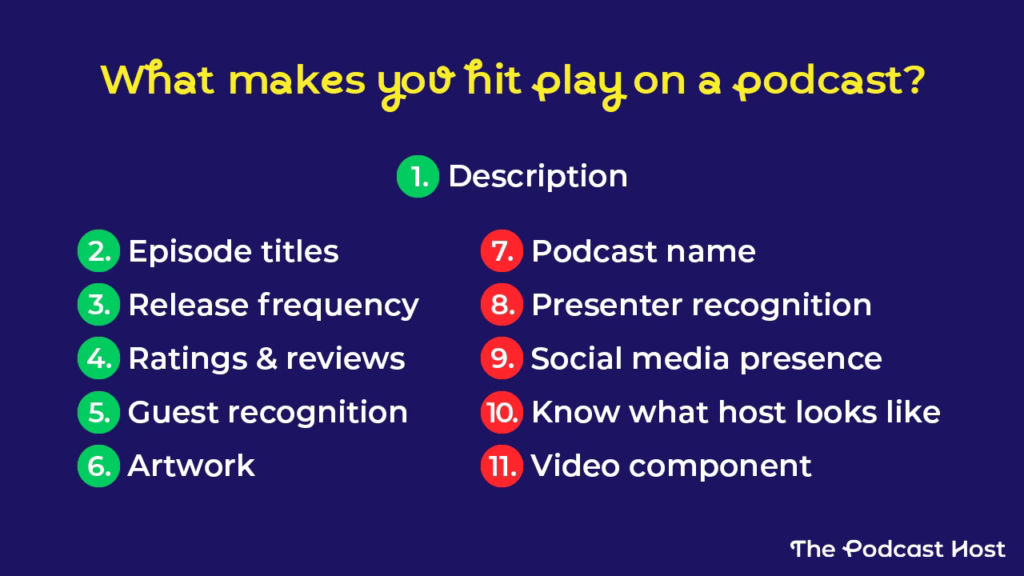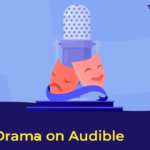Your Audio Drama Needs a Better Description—Here’s How
Over the past six years and nearly 300 issues of The Fiction Podcast Weekly, I’ve read thousands of podcast descriptions.
In the past year or so, I’ve noticed that many new audio drama and fiction podcasts have descriptions that follow a non-fiction format. But, fiction or audio drama podcasts have different audience expectations, so the needs are different.
Over the next few paragraphs, I’ll show you how to use your fiction-writing skills to craft a concise, plot-focused, and clear audio drama or fiction podcast description that’s easy to share and commit to.
Why Do Audio Drama and Fiction Podcast Descriptions Matter?
When I say “podcast description,” I don’t mean the episode descriptions or show notes. I’m talking about what the audience gets in exchange for paying attention to any or all of the episodes in this feed.
In our Discovery survey, we found that the podcast description is the top reason respondents choose a podcast.

We’ve written a comprehensive guide to writing nonfiction podcast descriptions. But fiction podcast descriptions have different expectations.
Nonfiction podcast descriptions speak to who the audience is in real life, while fiction podcasts speak to the audience’s imagination.
A nonfiction podcast description can promise what the audience will get in exchange for their attention, but fiction’s impact has too many variables to make those promises. The sole element podcasters can control, and the promise you can keep is what we’ll hear, not why we should listen.
How to Write a Fiction Podcast Description
50% of respondents to our Discovery survey told us that they start searching for new podcasts by opening up a podcast directory or app. Chances are good that your audience will find your description there or in a newsletter for podcast listeners or communities where people interested in audio drama or fiction podcasts congregate.
Your prospective audience knows what they’re looking for and where they want to find it.
Avoid Redundancies
Your podcast description doesn’t need to explain that your show is:
- A fiction or audio drama podcast
- A “movie for your ears,” “cinema of the mind,” or “radio play”
- Created by a brilliant writer or hard-working production team
Let it go.
People who search for audio drama and fiction know what a podcast is. What potential audiences don’t know is your story. That needs to be front and center in your podcast description.
Now that we’ve eliminated redundancies, let’s address what your podcast description needs and why. Your fiction or audio drama podcast needs to be:
- Shareable
- Easy to display in posts
- Actively focused on the plot
All three of these elements overlap with and complement each other. Let’s look at how to make these elements work best.
Brevity Makes the Magic Happen
Whether your podcast hosting service gives you 100 or 10,000 characters for your podcast description, the first characters matter most. Any time someone posts a link to your podcast on social media, the platform pulls a limited number of characters from the destination URL to describe that link.
How many?
Any number I research for you today could change tomorrow. Social media platforms can change their character display limits on a whim. And, platforms collapse posts to make scrolling easier. To show the audience what your podcast is about, you want to get the logline in the post’s first hundred or hundred and twenty-five characters. Here’s an example of how a podcast link appears on Bluesky:

I disappointed myself. Where’s the logline? It’s fragmented and hidden under the world-building. I’ve rewritten this description multiple times, but different directories display different versions of the description from my hosting service.
When a post clearly shows what to expect in the podcast, people are more likely to pay attention, and your fans can share the post easily. Keep your audio drama or fiction podcast description concise and to the point. The point, of course, is your logline, which we’ll get to next.
Stick to The Logline or Plot
When your fiction podcast description focuses on the logline, the audience knows what to expect. Your story might give audiences a world more vast and detailed than all of Lord of The Rings. First, you have to give the audience a point of entry. The logline gives casual browsers a handle to grab. Keep your podcast description concentrated on the throughline or narrative spine.
What Makes a Great Logline?
Screenwriters use the term logline; others call it a throughline, an elevator pitch, or a narrative sentence. You may have also heard the term “tagline,” which is different. Backstage Magazine has a detailed explanation of what a logline is and how to write a good one. In the meantime, let’s get back to your podcast description. Your logline needs to include the story’s:
- Primary character(s)
- Inciting incident
- Protagonist’s goal
- Conflict and stakes
Here’s an example using the description and tagline from Six Minutes.
“Eleven-year-old Holiday is pulled from the icy waters of Alaska with no memory of who she is or where she comes from. And when she begins to develop incredible abilities, she’ll soon learn she’s not alone in the world.”
The podcast art includes the tagline: “Before she was a girl… she was a weapon.”
The tagline implies the elements of the logline, but it’s shorter and more mysterious. Let’s return to the description and break down what makes it effective.
The logline tells you about the following:
- The primary character (Holiday, an eleven-year-old girl with memory loss)
- The inciting incident (pulled from the icy waters of Alaska)
- The primary character’s goal (learn she’s not alone in the world or learn her identity)
- The conflict and stakes (no memory, begins to develop incredible abilities)
The tagline informs our understanding of the main character, conflict, and stakes. But, it lacks specificity that gives the potential audience something to grasp. The podcast description tells us whose story this is, what they want, what’s in their way, and how they will get it.
Now that you know what elements to include, let’s clarify and polish your logline.
Clarity Matters
Many audio drama and fiction podcast writers labor over their scripts for years. Some of these stories have vast tomes of world-building knowledge, with religions, currencies, alphabets, laws, hierarchies, dynastic feuds, and revolutionary shoe fashions. Cool. And some people want to include all of this background information in the podcast description.
Your description has to pique their interest. Then, your episodes can help them invest emotionally. Once they’re cosplaying as your characters, you can sell the spinoff graphic encyclopedia and vinyl record set explaining all aspects of your audio drama universe. But first, the description has to give casual browsers a handle to grab.
There’s more lore in Lord of the Rings than in the Prose and Poetic Edda combined. But the Tolkienverse has influenced so many and endured for so long because, ultimately, it’s about an underdog who trades comfort for adventure. That’s seven words.
Take, for example, The Dex Legacy. This epic saga includes political intrigue, war profiteering, interplanetary colonization, and intergenerational trauma. How does one fit all of that into a pithy, contagious description?
“Join Varian, Isra, and Ren as they battle to maintain every ounce of their humanity against a despotic regime determined to turn them into monsters.”
That’s only 147 characters. I’m not saying this is easy. If you practice writing haiku, you may find it simpler.
In as few words as possible, tell us about the person who wants something and what they risk to achieve it. Don’t tell us their tactics or how the process changes them. Let us experience those actions and changes as an audience. When you keep your podcast description simple, we can find something familiar in the logline and latch on.
Active Voice Persuades
Surprise! All that time in seventh grade with Warriner’s English Grammar and Composition does matter. In the podcast descriptions I’ve shown you, nearly every verb uses active voice.
When you choose to use active or passive voice, neither is better or worse. But, active voice uses fewer words and implies forward motion. The sole exception is in the description for Six Minutes, where “Holiday is pulled from.” In this case, the passive verb tense avoids spoiling Holiday’s mystery or complicating the description.
Active voice piques your audience’s curiosity with a brief and dynamic description.
Don’t Be That Podcaster
Every time I edit the Fiction Podcast Weekly, I look for audio drama and fiction podcasts that have recently launched, published a new season, or reached a significant milestone.
Without fail, the podcast descriptions make me wonder who is telling these fiction podcasters to shove as many words into that podcast description as possible. At the same time, I’m scanning through all this text, exhaustedly praying for a logline, until I turn into Detective Mills at the climax of the movie Se7en, screaming, “WHAT’S IN THE BOX?” while John Doe drones on and on like a sad robot.
All audiences need to know is who wants what, how hard it will be to get, and what’s lit a fire under them this time.
Keep it brief, direct, and active.
Tell us what’s in the box so we can press play and share your show.
Sign up for the Fiction Podcast Weekly newsletter. Whether you’re a creator, avid listener, or just audio drama-curious, don’t miss out on getting this essential bulletin delivered to your inbox every Friday!

